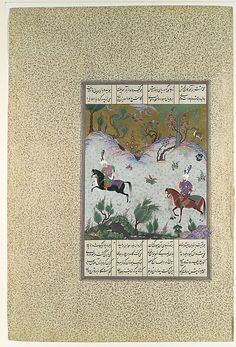Join Tessa Gratton and me as we read the Shahnameh by Abolqasem Ferdowsi. We’re using the Dick Davis translation (Penguin Classics).
If you haven’t already don’t forget to check out this AMAZING post by Rachel W in which she works out the complicated genealogy of our main and secondary characters.
This week we aren’t reading because Tessa has a deadline.
Next week: the first half of Rostam and Esfandyar.
Instead, a brief digression. I am reading POETICS AND POLITICS OF IRAN’S NATIONAL EPIC, THE SHAHNAMEH by Mahmoud Omidsalar. (Palgrave Macmillan)
I’m not far into it yet but basically he begins by examining, and refuting, the standard Western interpretations of the epic. I will give a report on what I’ve read on that aspect later.
For now: We’ve noted how translator Dick Davis has been skipping material, especially here in the middle. He gives some explanation of what and how he decided to abridge/leave out, and of course it is his decision to make as translator. But I was stunned to read this very emotional sequence in the introduction to Omidsalar’s book and am honestly puzzled why one would leave this out.
Seyavash, having foreseen his doom, takes his leave of Faragis, then goes to the stable and frees his favorite horse, Bihzad. This part is included, of course.
And we read (in synopsis) that the hero Giv finds Faragis and Kay Khosrow and escorts them to Iran. But what isn’t mentioned is this scene, which I will reproduce in its entirety (Omidsalar, p 4-5).
+++
the princess tells her son to take Bihzad’s saddle and halter to a nearby meadow where herds of horses come to drink water at midday. . . . Giv accompanies the young prince into the pastures.
The valiant lord mounted
And Giv walked in front, leading the way
They set out for a [nearby] hill
Where they could survey the fields
When the herd came by
And the horses drank their fill
Bihzad looked up, saw the prince,
And sighed piteously
He saw that saddle of Seyavash, covered in leopard’s skin
Those long stirrup leathers and the fine pommel
Resolutely, he stood at the waterhole
And did not move from where he was
Seeing his calm, Kay Khosrow
Treaded toward him with the saddle
He caressed and laid his cheek upon his face
He ran his fingers through his mane and touched him gently
Then the prince haltered and saddled him,
And remembered his [slain] father [to him].
When he mounted and steadied himself in the saddle
The colossal steed stirred
And rose like the wind.
It flew and vanished from Giv’s sight.
++
And here an illustration of Kay Khosrow riding Bihzad for the first time:


Yay, maybe I will catch up this week 🙂
And yeah…why DID this get cut out?
Completely agree, what an amazing passage! (And it’s not just because I obv think any and all horse passages should remain.)
I went and had a look at the book you’re reading and my library didn’t have it but the University library has a great interloan system so I put in a request. It’s possible I got a little carried away as I also requested two other books on the topic and the full, unabridged version of this epic (8 volumes!). http://cfis.columbia.edu/shahnameh Obviously I won’t actually have time to read all these books but I hope to at least browse through and read some relevant passages.
While searching Omidsalar I came by a review he wrote of Davis’ Epic and Sedition in 1992. He was quite positive about it but had some very specific critiques regarding translation. I thought it was really interesting. The review is in an academic journal so I can’t link it (well I can but then you have to buy it) but I have the pdf that I downloaded at work (lovely perk of a University job). If anyone is interested I’m happy to email it.
8 volume unabridged!!!
One of the interesting things about the Omidsalar book — and I say this with very little knowledge of Iran or the Shahnameh — is that he criticizes Western scholarship for its biases wrt discussion of Ferdowsi’s sources, and then later in the book when he is doing some analysis he uses what strike me as very uncritical Western Freudian analyses (cutting off a leg == castration metaphor) without apparently realizing that he’s replicating some of the most entrenched ways of looking at texts. But I don’t know, you know?